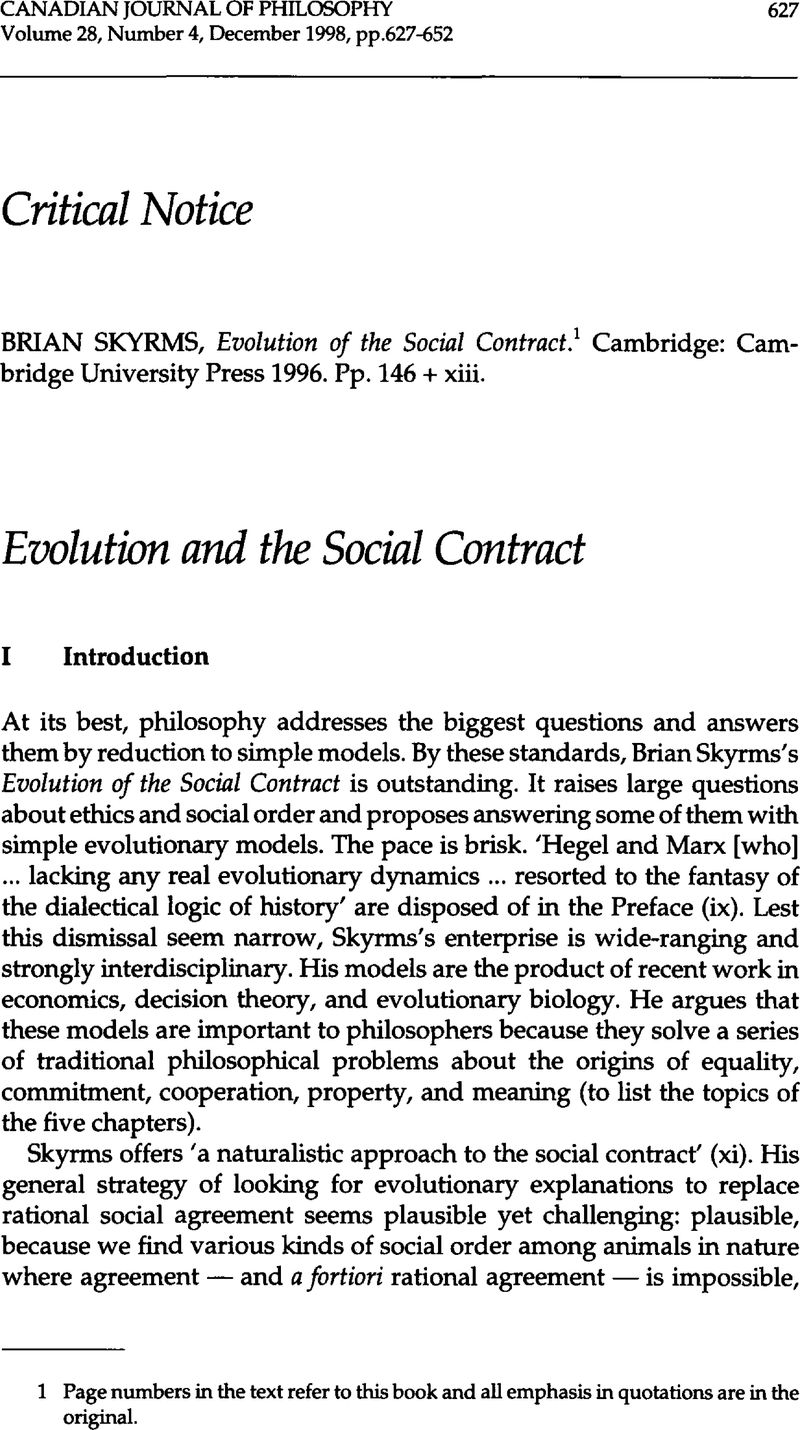Article contents
Brian Skyrms, Evolution of the Social Contract. Cambridge: Cambridge University Press 1996. Pp. 146 + xiii.
Published online by Cambridge University Press: 01 January 2020
Abstract

- Type
- Critical Notice
- Information
- Copyright
- Copyright © The Authors 1998
References
1 Page numbers in the text refer to this book and all emphasis in quotations are in the original.
2 Dawkins, D. The Selfish Gene 2nd ed. (Oxford: Oxford University Press 1989), 256Google Scholar
3 Quoted in Dennett, D. Darwin's Dangerous Idea (New York: Simon and Schuster 1995), 375Google Scholar.
4 Anonymous referee's comments.
5 Not exactly, since some is squandered in modest/modest encounters.
6 ‘Sex, Justice, and the Theory of Games,’ The journal of Philosophy 42, 12 (1996) 615-27, At 623
7 Justin D'Arms, R. Batterman, and K. Gorny, ‘Game Theoretic Explanations and the Evolution of Justice,’ unpublished typescript
8 With his practice, not his theory, as it were.
9 I pursue this constructive approach in Danielson, P. ‘The Evolution of Irrational Preferences,’ Colloquium on Philosophical Perspectives on Irrationality, University of Montreal, 1997.Google Scholar
10 Axelrod, Robert The Evolution of Cooperation (New York: Basic Books 1984), 177Google Scholar
11 It isn't. Wrapping the line into a ring (by making the end points neighbors) simplifies it further by giving all agents similar neighborhoods. Cf. Hegselmann, Rainer ‘Social Dilemmas in LineLand and Flatland,’ Frontiers in Social Dilemmas Research, Liebrand, Wim and Messick, David eds. (Berlin: Springer 1996)Google Scholar for the complex dynamics of this model.
12 Direct a Java-enabled WWW browser to <http://www.ethics.ubc.ca/eame/GenRing.html> for examples and a tutorial.
13 In addition, for completeness, each player needs a additional initial bit to select an initial move for which there is no past to provide a pattern input, but we will ignore this bit in what follows.
14 I discuss another model for the evolution of exploitation in Danielson (1996).
15 Wilson, David S. and Sober, Elliott ‘Reintroducing Group Selection to the Human Behavioral Sciences,’ Behavioral and Brain Sciences 17 (1994) 585–654, at 646CrossRefGoogle Scholar
16 For more on Russell's proposal that the West make a pre-emptive first strike, see Poundstone, William The Prisoner's Dilemma (New York: Doubleday 1992)Google Scholar; and Danielson, Peter ‘Prisoner's Dilemma Popularized: Game Theory and Ethical Progress,’ Dialogue 34 (1995) 295–304.Google Scholar
17 Smith, John Maynard and Price, G.R. ‘The Logic of Animal Conflict,’ Nature 146 (1973) 15–18CrossRefGoogle Scholar
18 Sugden, Robert ‘Spontaneous Order,’ Journal of Economic Perspectives 3 (1989) 85–97CrossRefGoogle Scholar. I benefit from a related form of illegal but tolerated appropriation in the beach community where I live; locals regularly destroy the beach access signs that our government puts up, in order to restrict access to those of us with local knowledge.
19 D. Gauthier, Morals by Agreement and Danielson, P. ‘The Visible Hand of Morality,’ Canadian Journal of Philosophy 18 (1988) 357–84CrossRefGoogle Scholar
20 Danielson, P. ‘Evolving Artificial Moralities: Genetic Strategies, Spontaneous Orders, and Moral Catastrophe,’ Chaos and Society, Albert, Alain ed. (Amsterdam: IOS Press 1996) 329–44Google Scholar
21 Skyrms, Brian The Dynamics of Rational Deliberation (Cambridge, MA: Harvard University Press 1990)Google Scholar
22 According to Hayek, F.A. Rules and Order, Vol 1 of Law, Legislation, and Liberty (Chicago: University of Chicago Press 1973), 21Google Scholar. In the sixteenth century natural ‘became a technical term for such social phenomena as were not deliberately shaped by human will.’
23 Sugden, Robert ‘Spontaneous Order,’ Journal of Economic Perspectives 3 (1989), 97CrossRefGoogle Scholar
24 Thanks to David Copp and Dale Rothman for their many helpful suggestions in our seminar on this book, and to Chris MacDonald for his comments on several drafts as well. Some of the models used in this notice were developed with support from SSHRC for my project ‘Evolving Artificial Moral Ecologies.’
- 3
- Cited by


